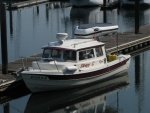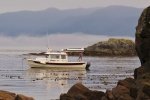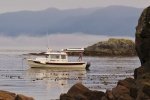I bet this has been discussed before but either I didn’t see it or don’t remember seeing it. So here it is: my new to me C-Dory came with about a gallon reservoir under tje sink. I think it’s kerosene because of its color and smell. It’s now less than half-full and I’m wondering what fuel I should refill with - diesel or kero. Any thoughts? I’d empty out what’s there and start new with any new fuel.
You are using an out of date browser. It may not display this or other websites correctly.
You should upgrade or use an alternative browser.
You should upgrade or use an alternative browser.
Wallas stove fuel
- Thread starter Pelican
- Start date
Salmon Fisher
Member
Your best bet is to call Scan Marine in Seattle and ask.
Give them the model number of your Wallas and they will happily tell you.
You're correct to safely dispose of the remaining fuel in the jug and put in fresh.
Your Wallas will thank you
Give them the model number of your Wallas and they will happily tell you.
You're correct to safely dispose of the remaining fuel in the jug and put in fresh.
Your Wallas will thank you
kennharriet
Member
I installed the Wallas 1300 last year. I have been using Jet A fuel after talking with Scan Marine. I get it at the pump at the local airport and it is half the cost of kerosine.
Thanks, everyone. I’ll call Scan Marine with the model #. It’s working like a charm now, but the starboard engine has to running for it to start up. I’m guessing the alternator gives the electrical system an extra boost to get it started. I’ve heard there’s a real problem if I let the reservoir run dry.
Salmon Fisher
Member
Yes, it is very important that the Wallas get enough electricity to fire up like it should.
You may want to look at your electrical system to make sure that either engine is wired so that your stove gets adequate juice to start. Do you have an (ACR) Automatic Charging Relay? This is very helpful if you have a Start battery.
What is your battery configuration? Do you have one Start battery and one House? Or do you have two deep cycle batteries? This what I run on my current 22 and it is fine. As an example, on our 2000 22 Cruiser with twin 40s, each had its own single pole Blue Seas On/Off switch wired to its own Group 24 battery. I modifed it to a Blue Seas Battery 1/2/1+2/Off so that both motors were charging one battery. I would start the trip on Battery 1. When I shut down motors at dock or mid trip, I would switch over to Battery 2 so it would get a charge. If I had installed an ACR, maybe I wouldn't have had to go through that sequence.
As discussed on this forum, you never want to select "1+2" because your outboard(s) do not have the capacity to charge both batteries.
Sounds like you're on the way to having a dependable Wallas.
You may want to look at your electrical system to make sure that either engine is wired so that your stove gets adequate juice to start. Do you have an (ACR) Automatic Charging Relay? This is very helpful if you have a Start battery.
What is your battery configuration? Do you have one Start battery and one House? Or do you have two deep cycle batteries? This what I run on my current 22 and it is fine. As an example, on our 2000 22 Cruiser with twin 40s, each had its own single pole Blue Seas On/Off switch wired to its own Group 24 battery. I modifed it to a Blue Seas Battery 1/2/1+2/Off so that both motors were charging one battery. I would start the trip on Battery 1. When I shut down motors at dock or mid trip, I would switch over to Battery 2 so it would get a charge. If I had installed an ACR, maybe I wouldn't have had to go through that sequence.
As discussed on this forum, you never want to select "1+2" because your outboard(s) do not have the capacity to charge both batteries.
Sounds like you're on the way to having a dependable Wallas.
Salmon Fisher":2xkb2ipl said:... As discussed on this forum, you never want to select "1+2" because your outboard(s) do not have the capacity to charge both batteries. ...
I suppose it depends on the engine(s), but I charge both my batteries (switch on Both) regularly with my single BF90D.
Start it with the lid up as well, the extra juice for the fan makes it hard to start on the older ones.
https://www.scanmarineusa.com/wp-conten ... -20121.pdf
https://www.scanmarineusa.com/wp-conten ... -20121.pdf
ssobol":3skfwmma said:Salmon Fisher":3skfwmma said:... As discussed on this forum, you never want to select "1+2" because your outboard(s) do not have the capacity to charge both batteries. ...
I suppose it depends on the engine(s), but I charge both my batteries (switch on Both) regularly with my single BF90D.
Mostly it depends on the batteries. If you are running your engine so the alternator is charging, it is usually fine to have both batteries connected together (A + B), as long as you are generating more amps than you are using. This can be a problem with the older Honda BF90s, which only put out about 17 amps. When one becomes fully charged, charging will shift to the other. With both fully charged, no amps will flow. The problem comes with connecting mis-matched batteries where there is no net charging. Directly connected (i.e. A+B switch only) batteries will try and equalize charges, always with a heat loss (laws of thermodynamics). Ultimately, those heat losses can drain your system. As mentioned above, there are various automatic methods for accomplishing the disconnect, an ACR, or better yet, a DC-DC system. These take the requirement of the operator moving the switch away. The DC-DC system will prioritize charging the starting battery, and then the house. When the engine is not running, the systems are isolated. There are some hybrid systems, like the Renogy DC-DC+MPPT, that have a computer that analyzes voltages and battery types, and can also charge the starting battery with solar panels. I completely agree about the need for adequate voltage for the Wallas. I have had this problem with the Wallas stoves in my C-Dory, camper, and yurt. So far, running the Wallas with LiFePO4 batteries hasn't yielded a problem as they keep voltage higher longer in the duty cycle.
Pelican,
Scan Marine is very helpful and they have a good website.
https://scanmarineusa.com
This is a post they have on fuels.
https://scanmarineusa.com/wp-content/up ... y-2020.pdf
I have been using Kleen Heat* for my Wallas. That and a specific protocol for starting and stopping has kept mine working every time I want it. So . . .
1. Burn Kleen Heet always, and never let the tank run below 1/4 full.
2. Always start it with the OB's running, and start it on HIGH and leave it there 15 minutes, at least.
3. Always run it on HIGH for the last 15 minutes before pushing the OFF button.
*Kleen Heet (Not sure of that spelling) may not be recommended by Scan on their website. I would ask them specifically about it for your specific stove. (I did).
If you don't know how old that fuel is, I would dump if an refill with fresh. (Henry's is a good source for the Kleen Heet.
See you on the water,
Harvey
SleepyC :moon

Scan Marine is very helpful and they have a good website.
https://scanmarineusa.com
This is a post they have on fuels.
https://scanmarineusa.com/wp-content/up ... y-2020.pdf
I have been using Kleen Heat* for my Wallas. That and a specific protocol for starting and stopping has kept mine working every time I want it. So . . .
1. Burn Kleen Heet always, and never let the tank run below 1/4 full.
2. Always start it with the OB's running, and start it on HIGH and leave it there 15 minutes, at least.
3. Always run it on HIGH for the last 15 minutes before pushing the OFF button.
*Kleen Heet (Not sure of that spelling) may not be recommended by Scan on their website. I would ask them specifically about it for your specific stove. (I did).
If you don't know how old that fuel is, I would dump if an refill with fresh. (Henry's is a good source for the Kleen Heet.
See you on the water,
Harvey
SleepyC :moon

As mentioned above, there are various automatic methods for accomplishing the disconnect, an ACR, or better yet, a DC-DC system.
Granted a DC -DC system is a necessity with LiFePO4 batteries (which has a resting voltage at 13.5 volts rather than 12.7 Volts of a FLA battery). An ACR will serve most C Dorys as well as a DC - DC system. If using Flooded Lead Acid (FLA) or AGM batteries, there is no reason for a DC to DC charger. All of the batteries. will have a similar charging profile. It is best to have all FLA batteries of Same type, same size, and same age. The Li battery has a different charging profile, which necessitates a DC to DC charger.
IF a LiFePO4 battery is at 12.8 volts it is 80% discharged.
Maybe we are just lucky, but with over 16 years and 4 different boats where we had the Wallas stove, we never had to run the outboard to start the Wallas. The stove should be connected directly to the battery, and adequate size wire should be used,
I am going to disagree with this statement also:
When one becomes fully charged, charging will shift to the other
When you have two batteries connected in parallel, and one has the charging leads directly to it, both batteries will be charging. Even with an ACR, the engine start battery will not be fully charged when the second battery begins to charge. The ACR will combine the batteries at about 13.6 volts. Most outboards charge in the 14 plus volts.
"Maybe we are just lucky, but with over 16 years and 4 different boats where we had the Wallas stove, we never had to run the outboard to start the Wallas. The stove should be connected directly to the battery, and adequate size wire should be used,"
I don't know that it has to be running, I do that as a precaution to save the battery, since I only have a DC volt level from my batteries, and it was suggested by one of the folks a Scan when I talked to them way back when I first started with the boat.
My Wallas is connected directly to the battery, and fused.
Harvey
SleepyC :moon

Make sure to confirm you do not have any corrosion in your wiring to the Wallas, they seem to be very sensitive to this. On the plus side, they have simple wiring and are easy to replace.
That is more of an issue for twin engines when both are charging the same battery (or a battery bank in parallel is the same). The charger regulator will mess with each other and they will cycle at a fast pace and shorten their lifespan.
Salmon Fisher wrote:
... As discussed on this forum, you never want to select "1+2" because your outboard(s) do not have the capacity to charge both batteries. ...
I suppose it depends on the engine(s), but I charge both my batteries (switch on Both) regularly with my single BF90D.
That is more of an issue for twin engines when both are charging the same battery (or a battery bank in parallel is the same). The charger regulator will mess with each other and they will cycle at a fast pace and shorten their lifespan.
When I had my Wallas 95D I asked Scan Marine about which fuel to use since at the time there were a lot of folks on here touting the Klean Heat stuff. The guy simply said that the D stood for diesel and that what it should be burning. I used diesel exclusively after that and it ran fine until the circuit board fried and the stove was replaced with an Espar.
The Klean Heat works well for people who use it and I am not saying there is anything wrong with using it. But I seem to recall it cost a whole lot more than the diesel and I would go broke keeping Lois warm for crabbing.
The Klean Heat works well for people who use it and I am not saying there is anything wrong with using it. But I seem to recall it cost a whole lot more than the diesel and I would go broke keeping Lois warm for crabbing.
Some of the stoves are designed to burn Diesel. Some are designed to burn Kerosene (which in some places is called Paraffine). Klean Heat is a Kerosene substitute. It is not Diesel.
I had a Kerosene stove and a Kerosene heater on my boat. I burned Klean Heat in both. In 8 years of heavy use, I had not a single issue with either one.
Again, you must know what model stove you have before you can know what fuel to burn.
I had a Kerosene stove and a Kerosene heater on my boat. I burned Klean Heat in both. In 8 years of heavy use, I had not a single issue with either one.
Again, you must know what model stove you have before you can know what fuel to burn.

